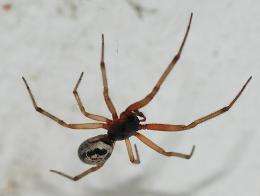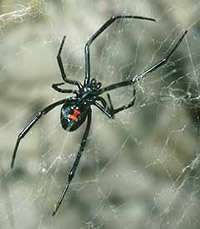Noble false widow spider marches north in the UK

The noble false widow spider, a species often mistaken for the black widow spider in the UK, is spreading north, Natural History Museum enquiry records show.
The noble false widow spider, Steatoda nobilis, is not native to the UK and was accidentally introduced more than 100 years ago from the Canary and Madeira islands, probably among crates of imported fruit.
It slowly established itself near the south coast, particularly in Dorset, Hampshire and Devon, and in the last 25 years has significantly increased its foothold in the UK.
Sightings of the noble false widow spider continue to come from further afield, and it is likely that climate change, and the warmer winters this brings, has contributed to this spider's continued colonisation of the UK.
The Museum’s Identification and Advisory Service (IAS) and the Identification forum get many enquiries about these arachnids each year. IAS manager Stuart Hine explains, ‘Steatoda nobilis continues to colonise the southern counties and could turn up almost anywhere in southern and midland counties.
"London records are increasing and I now have many living around the outside of my home near Reading."
Noble false widow spider
Like the black widow spider, the noble false widow spider has a striking bulbous abdomen, but it is brownish in colour rather than pitch black, usually with distinctive cream markings and reddish-orangey legs.

They feed on a wide variety of insects and other invertebrates that become trapped in their 'tangle webs'. Females can grow to 15mm, or 32mm including the legs.
Noble false widow spiders are most commonly found in and around domestic and commercial premises and usually make their webs a good height off the ground on external walls of houses and outbuildings.
Stuart says, "They appear to have a distinct preference for south facing walls and love conservatories and toilet blocks."
Spider bites
Both Steatoda and Latrodectus are in the same family of spiders called Theridiidae, the comb-footed spiders. They make similar 'tangle' webs, shown here.
Many of the IAS enquiries are from people worried that a noble false widow spider may bite. It is probably the UK’s most venomous spider but bites are rare and usually result from handling the spider roughly or from a spider being trapped between clothing and skin.
Bite symptoms are usually no more severe that a bee or wasp sting, but a handful of those who have been bitten have described more acute symptoms including throbbing pain, swelling and tingling in the fingers.
The IAS has received no more than 30 confirmed reports of noble false widow spider bites over a 16-year period.
False widow spiders in the UK
Of the around 650 species of spiders in the UK, 6 belong to the false widow group, or genus, Steatoda. All except Steatoda nobilis are native. They were given their name because they look like the black widow spiders.
The 2 false widow spiders most often mistaken for black widows are Steatoda grossa, the one that most resembles a black widow, and Steatoda bipunctata, known as the rabbit hutch spider.
Black widow spiders
Black widow spiders, which have a scary reputation because the females sometimes kill the male after mating, belong to the Latrodectus genus. They have a nasty bite that is occasionally fatal to humans.
Black widow spiders are found around the world, including North and South America, Australia and also southern Europe. Although individuals are occasionally imported with goods, they are unlikely to become established in the UK.
Provided by Natural History Museum


















